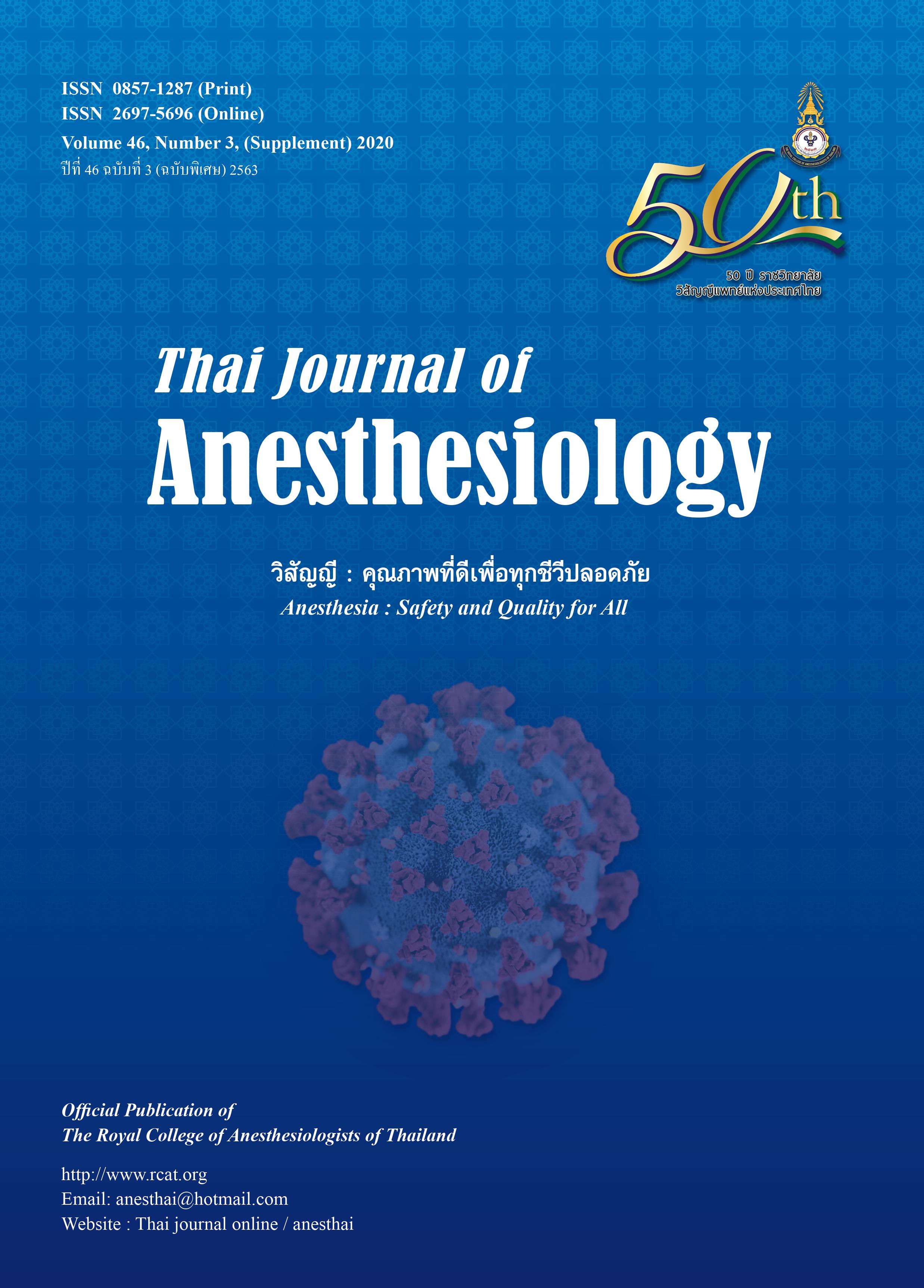New Normal Practice in Thoracic Anesthesia in Central Chest Institute of Thailand
Main Article Content
Abstract
During the COVID-19 pandemic, anesthesiologists
might be involved in the perioperative care of asymptomatic
COVID-19 patients undergoing thoracic surgery. There is
a higher exposure risk of thoracic anesthesiologist due to
the need to perform frequent aerosol-generating
procedures for thoracic surgery including bag-mask
ventilation, tracheal intubation, tracheal tube repositioning,
bronchoscopy, lung isolation, suction, correcting of hypoxia
during one-lung ventilation and tracheal extubation. The
modification in thoracic anesthesia practice in Central
Chest Institute of Thailand aims to minimize the risk to
healthcare professionals while providing effective
operative conditions and patient safety. The new normal
practice includes minimizing the number of staff present
in the operating room during aerosol-generating
procedures, preparation of personal protective equipment,
airway management plan and equipments with additional
acrylic box, closed-suction system and HEPA viral filter to
prevent spreading of droplets/aerosol. The choice of
tracheal tube for lung isolation depends on the indication,
difficulty of tracheal intubation and the need for
postoperative ventilation. The goals of safe aerosolgenerating
procedures during open airway are
pre-oxygenation, silent airway and no flow by reassuring
adequate neuromuscular blockade, discontinuation of
positive pressure ventilation at end-expiration, releasing
positive pressure by opening adjustable pressure limiting
valve, closed-suction and clamp the tube before
disconnection of breathing circuit and pass the flexible
bronchoscope through the valve of endotracheal tube
swivel connector and store in a designated area after use
to prevent contamination.
Article Details
References
2. สมาคมศัลยแพทย์ทรวงอกแห่งประเทศไทย. แนวทางเวชปฏิบัติ สำหรับการผ่าตัดมะเร็งปอดและโรคทรวงอกในภาวะการแพร่ ระบาดของโรคติดเชื้อ COVID-19 [Internet]. 2563[cited 20 April 2020]. Available from: http://thaists.org/pdf/2020/Guideines- F3-140563.pdf
3. Kucirka LM, Lauer SA, Laeyendecker O, et al. False-negative rate of RT-PCR SARS-CoV-2 Tests. J Am Coll Cardiol 2020. [Epub ahead of print]
4. Zou L, Ruan F, Huang M, et al. SARS-CoV-2 viral load in upper respiratory specimens of infected patients. N Engl J Med 2020; 382: 1177-9.
5. Sentürk M, El Tahan MR, Szegedi LL, et al. Thoracic anesthesia of patients with suspected or confirmed 2019 Novel Coronavirus infection: preliminary recommendations for airway management by the European Association of Cardiothoracic Anaesthesiology Thoracic Subspecialty Committee. J Cardiothorac Vasc Anesth 2020. doi: 10.1053/j. jvca.2020.03.059
6. Thornton M, Reid D, Shelley B, Steven M. Management of the airway and lung isolation for thoracic surgery during the COVID-19 pandemic. Anaesthesia 2020. doi.org/10.1111/ anae.15112
7. The Association of Anaesthetists. A suggestion for safe lung deflation during one-lung ventilation in COVID-19 suspect or positive patients [Internet]. 2020 [accessed 24/05/2020]. Available from: https://anaesthetists.org/Home/Resources-publications/COVID-19-guidance/A-suggestion-for-safe-lung-deflation-during-one-lung-ventilation-in-COVID- 19-suspect-or-positive-patients
8. Cook TM, El‐Boghdadly K, McGuire B, McNarry AF, Patel A, Higgs A. Consensus guidelines for managing the airway in patients with COVID ‐19. Anaesthesia 2020; 75: 785-99.
9. Meng L, Qiu H, Wan L, et al. Intubation and ventilation amid the COVID-19 outbreak: Wuhan’s experience. Anesthesiology 2020;132:1317-32.
1. Li W, Huang J, Guo X, et al. Anesthesia management and perioperative infection control in patients with the novel coronavirus. J Cardiothorac Vasc Anesth 2020. doi.org/ 10.1053/j.jvca.2020.03.035
2. Canelli R, Connor CW, Gonzalez M, et al. Barrier enclosure during endotracheal intubation. N Engl J Med 2020; 382: 1957-58.
3. Kucirka LM, Lauer SA, Laeyendecker O. Variation in false-negative rate of reverse transcriptase polymerase chain reaction–based SARS-CoV-2 tests by time since exposure. Ann Intern Med 2020. doi.org/10.7326/M20-1495
4. Gelzinis TA. Thoracic anesthesia in the COVID-19 Era. J Cardiothorac Vasc Anesth 2020. doi.org/10.1053%2Fj. jvca.2020.05.008
5. D’Silva DF, McCulloch TJ, Lim JS, et al. Extubation of patients with COVID-19. Br J Anaesth 2020. doi.org/10.1016/j. bja.2020.03.016
6. ราชวิทยาลัยวิสัญญีแพทย์แห่งประเทศไทย. แนวทางปฏิบัติการดูแลผู้ป่วยที่ติดเชื้อหรือสงสัยว่าติดเชื้อไวรัส COVID-19 ในการระงับความรู้สึก [Internet]. 2020 [accessed 24/05/2020]. Available from: http://www.anesthai.org/th/news/view/23


